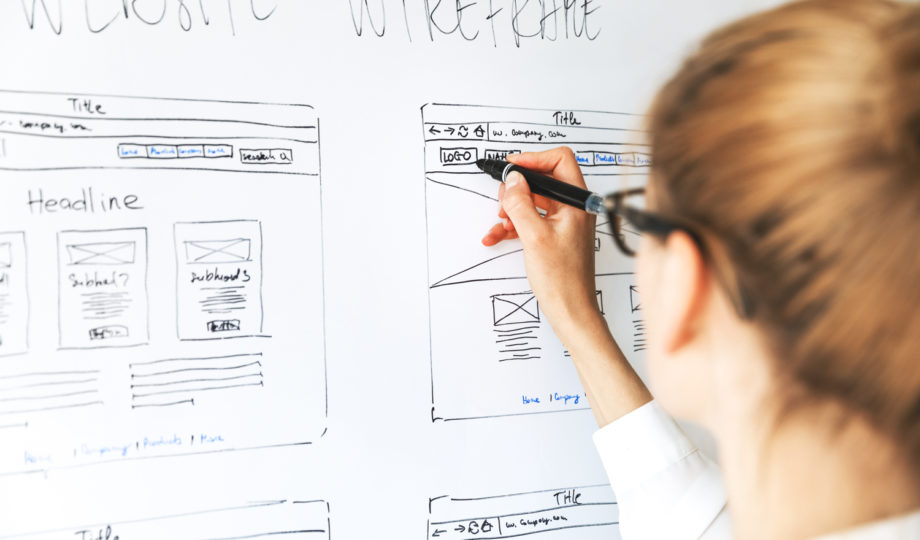
Prototyping and user testing are key components of user experience (UX) design and research. In fact, we wrote an entire three-part series on just that:
- Check out Part 1: Foundations of User Testing and Prototyping Check it out if you could use a refresher on the basics, including why we test with real users, when we test in the design process, and types of prototypes (e.g. low to high fidelity).
- Dive into Part 2: UX Research: Usability Testing Tools & Process For those interested in tackling usability testing, and learning more about moderated vs. unmoderated participant interaction, remote testing and tools, and consent and test protocol.
- Visit Part 3: Top UX Research Tips for Better Usability Test Reports For when you’re ready to synthesize the results of your usability test, analyze data from a usability test, and gather tips to use for your next report.
In addition to these posts, we’ve come up with a list of 10 tips for prototyping and testing that have the Outwitly stamp of approval. This blog post features our tried and true list!
Why do we prototype in UX design and research?
Prototyping and testing are important in UX design and research for a number of reasons. First and foremost, they allow designers to validate their ideas and ensure that the final product meets the needs and expectations of its intended users. By creating prototypes and testing them with real users, designers and researchers can identify problems and make improvements before the product is fully developed. This can save a lot of time and resources (like money) in the long run! After all, fixing problems in the design phase is much cheaper than trying to fix them after the product has been built.
Prototyping and testing also helps designers and researchers better understand the user’s perspective, and identify areas for improvement. By observing users as they interact with the product, they can gain valuable insights into how people actually use the product, and what they might find confusing or frustrating. This can help uncover problem areas, so that UX teams can come up with solutions to improve the overall user experience.
Finally, conducting prototyping and testing allows designers and researchers to build more engaging products. By gathering feedback from real users, they can finetune their designs to better meet the needs and preferences of their target audience. This results in products that are more intuitive, enjoyable, and effective at achieving an organization’s goals — the ultimate objective!
Need help with prototyping and user testing? Our team of UX professionals can put together the perfect action plan for reaching your organization’s goals.
Explore Our UX Design and Research Services
Our Top 10 Tips for Prototyping and Testing in UX Design
Here are some of our best tips and tricks for prototyping and user testing! Feel free to refer back to this list throughout the process if you’re feeling stuck.
- Start with a clear goal in mind. Before you begin prototyping or testing, it’s important to have a clear idea of what you hope to achieve. What questions do you want to answer? What problems are you trying to solve? Having a clear goal will help you stay focused and ensure that your efforts are directed toward achieving a specific outcome.
- Use the right level of fidelity for each stage of the design process. Your prototype’s level of fidelity should always match the current stage of the design process, and the goals you’ve set for the prototype. For example, a low-fidelity paper prototype might be sufficient for testing the overall layout and flow, while a high-fidelity digital prototype might be necessary for testing specific interactions, features and design elements. For more info on this, check out this previous blog post on user testing and prototyping foundations!
View this post on Instagram
3. Test with representative users. In order to get valuable feedback, it’s important to test your prototypes with a group of representative users. This might include members of your target audience, as well as people who fit specific demographics or have specific needs or goals. It’s important to always include the real users of your product in testing. It’s easy to assume we know what’s best for our users, but in actuality, we don’t! Read more on the benefits of testing with real users.
4. Observe and document user behaviour. As users interact with your prototypes, make sure to observe and document their behaviour. Pay attention to what they do, how they do it, and what they say. This will help you identify areas for improvement and gather valuable insights into how people actually use your product. We can make assumptions about how we think people will navigate a product or feature, but observing real users in action is the only way to know for sure. When it comes time to analyze the feedback you’ve received, try to identify common issues, and look for patterns. Check out the posts linked below for more tips on data analysis:
- Top UX Research Tips for Analyzing and Reporting on Usability Tests
- Data Analysis for UX and Design Research
5. Iterate and test again. Prototyping and testing are iterative processes. After gathering and analyzing feedback, make changes to your prototypes and test them again. Repeat this process until you have a product that meets the needs and expectations of your users.
6. Involve the right team members. The steps involved in prototyping and testing often require input and expertise from multiple team members, including designers, developers and product managers. You should also include stakeholders in your test sessions wherever possible, so they can see and hear user feedback first-hand! When stakeholders get involved, they’re able to learn about and fully appreciate the process of usability testing.
We have a few tips for including stakeholders:
- Try to only have one additional person attending usability test sessions, and set expectations with them beforehand. Let them know that once introductions have been made, they should observe only, and remain on mute for the duration of the test. Let them know that if they have questions, you’re more than happy to answer them afterwards.
- Don’t bias the test. If having stakeholders attend the test would bias the users or make them uncomfortable, then it would be better to avoid bringing the stakeholders in, at least for the particular test in question. The presence of this issue will depend on the nature of the product and who the users are.
The main takeaway here is to involve the right people in the process, ensure that all perspectives are considered, and set your team up to create the best possible final product.
7. Keep an open mind, and don’t be afraid to fail. As you prototype and test your designs, it’s important to be open-minded and willing to consider new ideas and approaches. We recommend adopting a beginner’s mindset! Don’t get too attached to your initial ideas and be ready to pivot if necessary. As designers, we need to take an egoless approach to our work, and understand that it’s okay if certain features aren’t easy to find at first, or if users have had “negative” feedback. All feedback is good! It will ultimately make your work (and the product) better. Don’t let fear of failure hold you back. Embrace the unknown and be open to taking risks. Sometimes the greatest innovations come from unexpected failures.
8. Celebrate your successes. When you finally create a prototype that works as intended, or you receive positive feedback from test users, it’s important to take a moment to celebrate your successes. This can help boost morale and encourage the team to continue pushing forward with the project. The same goes for your report: make sure to include positive feedback and kudos on the things that work well, so that your clients or stakeholders aren’t deflated by all the usability issues you find. Follow these tips for usability test reports!
9. Use the right tools. There are a wide variety of tools available to help you prototype and test your designs. For designing prototypes, we like Figma, Adobe XD, or InvisionApp. For testing, there are some great tools and services like Usertesting.com, Lookback, Maze, or UX Tweak. Ultimately, you’ll need to choose the right tools for your needs and make sure to keep an eye out for new and innovative tools that can help streamline your work. Just remember, sometimes it’s best to keep it simple and use basic web conferencing tools like Zoom. If you use a tool your organization has already adopted, then you won’t have to worry about getting permission to purchase another subscription, or dedicating time to learning a new tool!
10. Only test a few tasks or features at once. Don’t try to test too many things at a time. We recommend testing three to five tasks or features in one session. Otherwise, you’ll risk not getting through all the tasks/features with each participant, or taking too long to run the test. In your first rounds of testing, focus on the overall concept and core functionality. As you continue with later rounds of testing, you can get more specific, and test smaller features.
We hope the tips in this blog post will help you to conduct your best prototyping and user testing sessions yet! AND, don’t forget to check out our three-part series on UX prototyping and testing:




